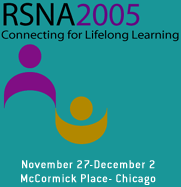
Abstract Archives of the RSNA, 2005
Kevin Marin Baskin MD, Presenter: Nothing to Disclose
Miguel Hernandez-Pampaloni MD,PHD, Abstract Co-Author: Nothing to Disclose
Ghassan El-Haddad MD, Abstract Co-Author: Nothing to Disclose
Abass Alavi MD, Abstract Co-Author: Nothing to Disclose
Richard Bruce Towbin MD, Abstract Co-Author: Nothing to Disclose
To evaluate the potential contribution of PET-CT guided percutaneous interventions.
15 oncology patients (age 12±3 years, weight 50±19 kg) were referred for open surgical biopsy after CT and PET studies. The biopsies showed lymphoma (7), neuroblastoma (2), renal cell carcinoma (1), osteosarcoma (1), gastrointestinal stromal tumor (1) or neurofibromatosis (1), while 2 were non-diagnostic. Interventional radiologists (IR) assessed CT studies for all patients, and prospectively marked the most likely sites for percutaneous biopsy. Lesions were ranked by IR preference for risk and accessibility. Nuclear physicians reviewed contemporaneous whole body PET studies for 18-F FDG-avid lesions. Only lesions with a standardized uptake value (SUV) ≥ 2.0 were included. Both groups were blinded to the others' results. The PET and CT studies were fused, and for each lesion identified on CT the proportion of avid FDG uptake on PET was calculated and the proportion of the lesion crossed by the planned biopsy route was estimated.
3 patients were excluded from analysis for negative CT and PET studies. 2 patients had suspicious lesions on CT with no abnormalities on PET. In the remaining 10 patients, 19 PET lesions with SUV≥2 were not identified on CT. Conversely, 12 lesions on CT were negative on PET. 21 lesions were identified on both modalities, with a mean cross-sectional area on CT of 740±947 mm2, and a mean SUV of 4.8±3.3. Only 43%±23% of the average CT lesions met the SUV threshold. For 12 lesions, the planned biopsy route crossed ≥50% of the FDG-avid area. For the other 9 lesions only 13±14% of the active lesion was crossed. Information from PET-CT fusion would have altered the preferred biopsy site in 3/15 (20%) patients and indicated against biopsy in 3/15 (20%) patients.
Minimally-invasive PET-CT guided interventions are a feasible alternative to conventional approaches for biopsy in patients with suspected extracranial neoplasms. Fused images add information in selected cases that may alter the choice of biopsy site, and may increase both safety and yield of percutaneous procedures by identifying metabolically active targets.
K.M.B.: US 6,175,760 B1 Nuclear Medicine Localization Needle, with William Barnhart.
Baskin, K,
Hernandez-Pampaloni, M,
El-Haddad, G,
Alavi, A,
Towbin, R,
PET-CT-guided Interventions in Oncology Patients: A Model for Comparison with Conventional Approaches to Tissue Diagnosis. Radiological Society of North America 2005 Scientific Assembly and Annual Meeting, November 27 - December 2, 2005 ,Chicago IL.
http://archive.rsna.org/2005/4409616.html

